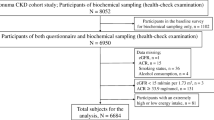Abstract
Background
Although several studies have investigated the relationship between dietary nutrient intake and microalbuminuria, no study of an Asian population has been reported. The present study investigates the relationship between dietary intake and microalbuminuria in a general Japanese population.
Methods
We analyzed 675 men and 924 women who did not have diabetes. Participants who had a urinary albumin-to-creatinine ratio (UACR) ≥300 mg/g, who did not complete a questionnaire regarding food frequency and who did not provide complete urine measurements were excluded. Nutrient intake was assessed by validated food frequency questionnaire. Microalbuminuria was defined as UACR ≥30 mg/g. The relationship between dietary nutrient intake and microalbuminuria was examined using a multiple logistic regression model adjusted for age, total energy intake, body mass index, smoking status, systolic blood pressure and use of antihypertensive medication.
Results
No significant association was observed among the men. The multiple adjusted odds ratios (95% confidence interval) of having microalbuminuria per 1 standard deviation increase in total protein (%kcal), animal protein (%kcal), animal protein (g/day), animal fat, niacin, carbohydrate and β-cryptoxanthin among the women were 1.33 (1.07–1.66), 1.35 (1.09–1.66), 1.42 (1.08–1.88), 1.29 (1.05–1.59), 1.28 (1.04–1.57), 0.73 (0.58–0.92) and 0.76 (0.59–0.996), respectively. The multiple adjusted odds ratio (95% confidence interval) of having microalbuminuria in the highest quintile of n–3 polyunsaturated fatty acids compared with the lowest was 2.16 (1.03–4.54).
Conclusion
Less animal protein and more β-cryptoxanthin in the diet might help to prevent microalbuminuria. Prospective studies including controlled trials are required to confirm this conclusion.
Similar content being viewed by others
References
Perkovic V, Verdon C, Ninomiya T, Barzi F, Cass A, Patel A, et al. The relationship between proteinuria and coronary risk: a systematic review and meta-analysis. PLoS Med. 2008;5:207.
Lee M, Saver JL, Chang KH, Liao HW, Chang SC, Ovbiagele B. Impact of microalbuminuria on incident stroke: a meta-analysis. Stroke. 2010;41:2625–31.
Solbu MD, Kronborg J, Jenssen TG, Njølstad I, Løchen ML, Mathiesen EB, et al. Albuminuria, metabolic syndrome and the risk of mortality and cardiovascular events. Atherosclerosis. 2009;204:503–8.
Konta T, Hao Z, Abiko H, Ishikawa M, Takahashi T, Ikeda A, et al. Prevalence and risk factor analysis of microalbuminuria in Japanese general population: the Takahata study. Kidney Int. 2006;70:751–6.
Wrone EM, Carnethon MR, Palaniappan L, Fortmann SP. Third National Health and Nutrition Examination Survey. Association of dietary protein intake and microalbuminuria in healthy adults: Third National Health and Nutrition Examination Survey. Am J Kidney Dis. 2003;41:580–7.
Lin J, Hu FB, Curhan GC. Associations of diet with albuminuria and kidney function decline. Clin J Am Soc Nephrol. 2010;5:836–43.
Nettleton JA, Steffen LM, Palmas W, Burke GL, Jacobs DR Jr. Associations between microalbuminuria and animal foods, plant foods, and dietary patterns in the Multiethnic Study of Atherosclerosis. Am J Clin Nutr. 2008;87:1825–36.
Daviglus ML, Greenland P, Stamler J, Elliott P, Appel LJ, Carnethon MR, et al. Relation of nutrient intake to microalbuminuria in nondiabetic middle-aged men and women: International Population Study on Macronutrients and Blood Pressure (INTERMAP). Am J Kidney Dis. 2005;45:256–66.
Lee CT, Adler AI, Forouhi NG, Luben R, Welch A, Khaw KT, et al. Cross-sectional association between fish consumption and albuminuria: the European Prospective Investigation of Cancer—Norfolk Study. Am J Kidney Dis. 2008;52:876–86.
Suzuki K, Konta T, Takasaki S, Ikeda A, Ichikawa K, Sato H, et al. High variability of albuminuria in nondiabetic population: the Takahata Study. Clin Exp Nephrol. 2009;13:452–9.
Kudo K, Konta T, Mashima Y, Ichikawa K, Takasaki S, Ikeda A, et al. The association between renal tubular damage and rapid renal deterioration in the Japanese population: the Takahata study. Clin Exp Nephrol. 2011; 15: 235-241.
Japanese Society of Nephrology. Evidence-based practice guideline for the treatment of CKD. Clin Exp Nephrol. 2009;13:537–66.
Sasaki S. Serum biomarker-based validation of a brief-type self-administered diet history questionnaire for Japanese subjects. A research for assessment of nutrition and dietary habit in “Kenko Nippon 21.” Tokyo: The Study Group of Ministry of Health, Labor and Welfare of Japan; 2005. pp. 10–42 (in Japanese).
Ford ES, Giles WH, Mokdad AH, Ajani UA. Microalbuminuria and concentrations of antioxidants among US adults. Am J Kidney Dis. 2005;45:248–55.
Rowley K, O’Dea K, Su Q, Jenkins AJ, Best JD. Low plasma concentrations of diet-derived antioxidants in association with microalbuminuria in Indigenous Australian populations. Clin Sci (Lond). 2003;105:569–75.
Hozawa A, Jacobs DR Jr, Steffes MW, Gross MD, Steffen LM, Lee DH. Associations of serum carotenoid concentrations with the development of diabetes and with insulin concentration: interaction with smoking: the Coronary Artery Risk Development in Young Adults (CARDIA) Study. Am J Epidemiol. 2006;163:929–37.
Hozawa A, Jacobs DR Jr, Steffes MW, Gross MD, Steffen LM, Lee DH. Circulating carotenoid concentrations and incident hypertension: the Coronary Artery Risk Development in Young Adults (CARDIA) study. J Hypertens. 2009;27:237–42.
Anderson CA, Appel LJ, Okuda N, Brown IJ, Chan Q, Zhao L, et al. Dietary sources of sodium in China, Japan, the United Kingdom, and the United States, women and men aged 40 to 59 years: the INTERMAP study. J Am Diet Assoc. 2010;110:736–45.
Acknowledgments
This study was supported by a grant-in-aid from the 21st Century Center of Excellence (COE) and the Global COE Program of the Japan Society for the Promotion of Science. This study was also supported by a Grant-in-Aid for Young Scientists (A) (21689018) from the Ministry of Education, Culture, Sports, Science and Technology, Japan.
Conflict of interest
There are no potential conflicts of interest.
Author information
Authors and Affiliations
Corresponding author
About this article
Cite this article
Sato, M., Hozawa, A., Konta, T. et al. Relationship between dietary intake and microalbuminuria: findings from the Takahata study. Clin Exp Nephrol 16, 147–155 (2012). https://doi.org/10.1007/s10157-011-0539-5
Received:
Accepted:
Published:
Issue Date:
DOI: https://doi.org/10.1007/s10157-011-0539-5



